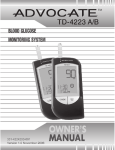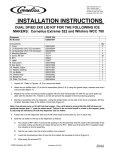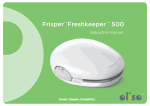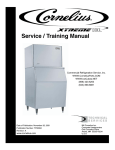Download Cornelius 700 - Series Service manual
Transcript
® CONTINUOUS FLOW ICEMAKER 500, 700, 1000, 2000 - Series Service Manual Distributed By: Commercial Refrigeration Service, Inc. http://www.CorneliusParts.COM http://www.IceCubes.NET toll free (866) Ice Maker (623) 869-8881 Release Date: May 27, 2004 Publication Number: 630460174SER Revision Date: September 24, 2008 Revision: D Visit the IMI Cornelius web site at www.cornelius.com for all your Literature needs. CONTINUOUS FLOW ICEMAKER SERVICE MANUAL The products, technical information, and instructions contained in this manual are subject to change without notice. These instructions are not intended to cover all details or variations of the equipment, nor to provide for every possible contingency in the installation, operation or maintenance of this equipment. This manual assumes that the person(s) working on the equipment have been trained and are skilled in working with electrical, plumbing, pneumatic, and mechanical equipment. It is assumed that appropriate safety precautions are taken and that all local safety and construction requirements are being met, in addition to the information contained in this manual. To inquire about current revisions of this and other documentation or for assistance with any Cornelius product contact: www.cornelius.com 800-238-3600 Trademarks and copyrights: Aurora, Cornelius, Decade, Hydro Boost, Sitco, Spirit, UF-1, Vanguard, Venture, Olympus, and Vista are registered trademarks of IMI Cornelius Inc. Optifill trademark is pending. This document contains proprietary information and it may not be reproduced in any way without permission from Cornelius. Printed in U.S.A. Copyright © 2004-2008, All Rights Reserved, IMI Cornelius, Inc. Distributed By: Commercial Refrigeration Service, Inc. http://www.CorneliusParts.COM http://www.IceCubes.NET toll free (866) Ice Maker (623) 869-8881 Continuous Flow Icemaker Service Manual Safety . . . . . . . . . . . . . . . . . . . . . . . . . . . . . . . . . . . . . . . . . . . . . . . . . . . . . . . . . . . . . . . .1 Safety Instructions . . . . . . . . . . . . . . . . . . . . . . . . . . . . . . . . . . . . . . . . . . . . . . . . . . .1 Read and Follow all Safety Instructions . . . . . . . . . . . . . . . . . . . . . . . . . . . . . . . .1 Recognize Safety Alerts . . . . . . . . . . . . . . . . . . . . . . . . . . . . . . . . . . . . . . . . . . . .1 Different Types of Alerts . . . . . . . . . . . . . . . . . . . . . . . . . . . . . . . . . . . . . . . . . . . .1 Safety Tips . . . . . . . . . . . . . . . . . . . . . . . . . . . . . . . . . . . . . . . . . . . . . . . . . . . . . . . . .1 Qualified Service Personnel . . . . . . . . . . . . . . . . . . . . . . . . . . . . . . . . . . . . . . . . . . . .1 Shipping And Storage . . . . . . . . . . . . . . . . . . . . . . . . . . . . . . . . . . . . . . . . . . . . . . . . .1 General Description . . . . . . . . . . . . . . . . . . . . . . . . . . . . . . . . . . . . . . . . . . . . . . . . . . . .2 Specification Chart . . . . . . . . . . . . . . . . . . . . . . . . . . . . . . . . . . . . . . . . . . . . . . . . . . .2 Bin Control . . . . . . . . . . . . . . . . . . . . . . . . . . . . . . . . . . . . . . . . . . . . . . . . . . . . . . . . .5 Gearmotor . . . . . . . . . . . . . . . . . . . . . . . . . . . . . . . . . . . . . . . . . . . . . . . . . . . . . . . . . .5 Cleaning and Sanitizing . . . . . . . . . . . . . . . . . . . . . . . . . . . . . . . . . . . . . . . . . . . . . . . . .6 Icemaker Cleaning and Sanitizing Procedures . . . . . . . . . . . . . . . . . . . . . . . . . . . . . .6 Maintenance . . . . . . . . . . . . . . . . . . . . . . . . . . . . . . . . . . . . . . . . . . . . . . . . . . . . . . . .6 Monthly . . . . . . . . . . . . . . . . . . . . . . . . . . . . . . . . . . . . . . . . . . . . . . . . . . . . . . . . . . . .6 Quarterly . . . . . . . . . . . . . . . . . . . . . . . . . . . . . . . . . . . . . . . . . . . . . . . . . . . . . . . . . . .6 Semi-annually . . . . . . . . . . . . . . . . . . . . . . . . . . . . . . . . . . . . . . . . . . . . . . . . . . . . . . .7 Water Level Control . . . . . . . . . . . . . . . . . . . . . . . . . . . . . . . . . . . . . . . . . . . . . . . . . . . .8 How Water Level Control Works . . . . . . . . . . . . . . . . . . . . . . . . . . . . . . . . . . . . . . . . .8 Purpose . . . . . . . . . . . . . . . . . . . . . . . . . . . . . . . . . . . . . . . . . . . . . . . . . . . . . . . . . . . .8 To Replace Water Level Control . . . . . . . . . . . . . . . . . . . . . . . . . . . . . . . . . . . . . . . . .8 To Replace Water Level Safety Switch . . . . . . . . . . . . . . . . . . . . . . . . . . . . . . . . . . . .8 Electrical . . . . . . . . . . . . . . . . . . . . . . . . . . . . . . . . . . . . . . . . . . . . . . . . . . . . . . . . . . . . .9 Refrigeration System . . . . . . . . . . . . . . . . . . . . . . . . . . . . . . . . . . . . . . . . . . . . . . . . . .12 Refrigeration System Adjustments . . . . . . . . . . . . . . . . . . . . . . . . . . . . . . . . . . . . . .12 Expansion Valve . . . . . . . . . . . . . . . . . . . . . . . . . . . . . . . . . . . . . . . . . . . . . . . . . . . .12 Adjustment and Troubleshooting . . . . . . . . . . . . . . . . . . . . . . . . . . . . . . . . . . . . . . .12 Condenser Modulating Valve . . . . . . . . . . . . . . . . . . . . . . . . . . . . . . . . . . . . . . . . . .13 Condenser Modulating Valve Removal . . . . . . . . . . . . . . . . . . . . . . . . . . . . . . . . . . .14 Motor Check . . . . . . . . . . . . . . . . . . . . . . . . . . . . . . . . . . . . . . . . . . . . . . . . . . . . . . .15 Start Relay . . . . . . . . . . . . . . . . . . . . . . . . . . . . . . . . . . . . . . . . . . . . . . . . . . . . . . . .15 To Replace Gearmotor Assembly . . . . . . . . . . . . . . . . . . . . . . . . . . . . . . . . . . . . . . .15 Installation and Shaft Seal Replacement 500 . . . . . . . . . . . . . . . . . . . . . . . . . . . . . .16 Auger and Extruding Head Removal . . . . . . . . . . . . . . . . . . . . . . . . . . . . . . . . . . . .16 Installation and Shaft Seal Replacement 700 & 1000 . . . . . . . . . . . . . . . . . . . . . . . .17 Upper Nut and Bearing Assembly . . . . . . . . . . . . . . . . . . . . . . . . . . . . . . . . . . . . . . .17 To Replace Bearing . . . . . . . . . . . . . . . . . . . . . . . . . . . . . . . . . . . . . . . . . . . . . .17 Electrical Checkout . . . . . . . . . . . . . . . . . . . . . . . . . . . . . . . . . . . . . . . . . . . . . . . . . .17 Overload Check . . . . . . . . . . . . . . . . . . . . . . . . . . . . . . . . . . . . . . . . . . . . . . . . . . . .18 Compressor Check . . . . . . . . . . . . . . . . . . . . . . . . . . . . . . . . . . . . . . . . . . . . . . . . . .18 Capacitor Check . . . . . . . . . . . . . . . . . . . . . . . . . . . . . . . . . . . . . . . . . . . . . . . . . . . .18 Safety Controls . . . . . . . . . . . . . . . . . . . . . . . . . . . . . . . . . . . . . . . . . . . . . . . . . . . . .19 Troubleshooting . . . . . . . . . . . . . . . . . . . . . . . . . . . . . . . . . . . . . . . . . . . . . . . . . . . . . .21 © 2004-2005, IMI Cornelius Inc. -i- Publication Number: 630460174SER Continuous Flow Icemaker Service Manual Publication Number: 630460174SER - ii - © 2004-2005, IMI Cornelius Inc. Continuous Flow Icemaker Service Manual SAFETY SAFETY INSTRUCTIONS Read and Follow all Safety Instructions Read and follow all safety instructions in this manual and on the machine (decals, labels, and laminated cards). Read and understand all applicable OSHA (Occupation Safety and Health Administration) safety regulations before operating the machine. Recognize Safety Alerts This is the safety alert symbol. When you see it in this manual or on the machine be alert to the potential of personal injury or damage to the machine. Different Types of Alerts There are 3 types of safety alerts: DANGER — Indicates an immediate hazardous situation which if not avoided WILL result in serious injury, death, or equipment damage. WARNING — Indicates a potentially hazardous situation which, if not avoided, COULD result in serious injury, death, or equipment damage. CAUTION — Indicates a potentially hazardous situation which, if not avoided, MAY result in minor or moderate injury or equipment damage. SAFETY TIPS • Carefully read all safety messages in this manual and safety signs on the machine. • Keep safety signs in good condition and replace missing or damaged safety signs. • Learn how to operate the machine and how to use the controls properly. • Do not let anyone operate the machine without proper training. This appliance is not intended for use by very young children or infirm persons without supervision. Young children should be supervised to ensure that they do not play with the appliance. • Keep your machine in proper working condition and do not allow unauthorized modifications to the machine. QUALIFIED SERVICE PERSONNEL CAUTION — Only trained and certified electrical, plumbing and refrigeration technicians should service this unit. ALL WIRING AND PLUMBING MUST CONFORM TO NATIONAL AND LOCAL CODES. SHIPPING AND STORAGE CAUTION — Before shipping, storing, or relocating the Unit, syrup systems must be sanitized and all sanitizing solution must be purged from the syrup systems. All liquids, after sanitizing, must be purged from the unit. A freezing ambient environment will cause residual sanitizing solution or water remaining inside the Unit to freeze resulting in damage to the internal components. © 2004-2005, IMI Cornelius Inc. -1- Publication Number: 630460174SER Continuous Flow Icemaker Service Manual GENERAL DESCRIPTION This section gives the Unit description, theory of operation, and design data for continuous flow icemaker series 500, 700, 1000, and 2000. SPECIFICATION CHART Models Condensing Unit VAC HZ WCC500-A WCC500-W WCC502-A WCC502-W WCF510-A WCF510-W WCF512-A WCF512-W WCC700-A WCC700-W WCC701-A WCC701-W WCC702-A WCC702-W WCF710-A WCF710-W WCC711-A WCC711-W WCF712-A WCF712-W WCC1001-A WCC1001-W WCC1002-A WCF1101-A WCF1101-W WCF1102-A WCC1001-R WCF1101-R WCC2001–A WCC2001–R WCC2001–W WCC2002–A WCF2201–A WCF2201–W WCF2202–A Air Cooled Water Cooled Air Cooled Water Cooled Air Cooled Water Cooled Air Cooled Water Cooled Air Cooled Water Cooled Air Cooled Water Cooled Air Cooled Water Cooled Air Cooled Water Cooled Air Cooled Water Cooled Air Cooled Water Cooled Air Cooled Water Cooled Air Cooled Air Cooled Water Cooled Air Cooled Remote Remote Air–Cooled Remote Water Cooled Air Cooled Air–Cooled Water Cooled Air Cooled 115 115 220/240 220/240 115 115 220/240 220/240 115 115 208/230 208/230 220/240 220/240 115 115 208/230 208/230 220/240 220/240 208/230 208/230 220/240 208/230 208/230 220/240 220/240 208/230 208/230 208/230 208/230 220/240 208/230 208/230 220/240 60 60 50 50 60 60 50 50 60 60 60 60 50 50 60 60 60 60 50 50 60 60 50 60 60 50 60 60 60 60 60 50 60 60 50 PH Wire 1 1 1 1 1 1 1 1 1 1 1 1 1 1 1 1 1 1 1 1 1 1 1 1 1 1 1 1 1 1 1 1 1 1 1 2 2 2 2 2 2 2 2 2 2 2 2 2 2 2 2 2 2 2 2 2 2 2 2 2 2 2 2 2 2 2 2 2 2 2 Comp. Fan RLA Amps 10.1 10.1 5.3 5.3 10.1 10.1 5.3 5.3 12 12 7.7 7.7 8.2 8.2 12 12 7.7 7.7 8.2 8.2 7.5 7.5 8.9 7.5 7.5 8.9 7.5 7.5 12.9 12.9 12.9 11.4 12.9 12.9 11.4 1.1 N/A 0.5 N/A 1.1 N/A 0.5 N/A 1.6 N/A 1.6 N/A 0.5 N/A 1.6 N/A 1.6 N/A 0.5 N/A 0.85 N/A 0.85 0.85 N/A 0.85 N/A N/A .85 1.7 N/A .85 .85 N/A .85 GRMT R Amps 2 2 1.6 1.6 2 2 1.6 1.6 2 2 2 2 1.6 1.6 2 2 2 2 1.6 1.6 2 2 2 2 2 2 2 2 (2) 2 (2) 2 (2) 2 (2) 2 (2) 2 (2) 2 (2) 2 Refrigerant Oz. Type 24 11 24 11 24 11 24 11 24 13 24 13 24 13 24 13 24 13 24 13 26 17 26 26 17 26 120 120 46 220 28 46 46 28 46 R404A R404A R404A R404A R404A R404A R404A R404A R404A R404A R404A R404A R404A R404A R404A R404A R404A R404A R404A R404A R404A R404A R404A R404A R404A R404A R404A R404A R404A R404A R404A R404A R404A R404A R404A Circuit Fuse 20 20 20 20 20 20 20 20 20 20 20 20 20 20 20 20 20 20 20 20 20 20 20 20 20 20 15 15 25 25 25 25 25 25 25 NOTE: For units not listed in above chart, refer to nameplate or contact factory service. 80 70 60 –70 –90 –100 Publication Number: 630460174SER 600 1000 450 400 Capacity Lbs./24 hr. 1100 500 900 800 700 600 350 90 Air Temperature Deg. F 650 550 50 Water Temperature Deg. F –50 Capacity Lbs./24 hr. 340 320 300 280 260 240 90 WCC1000 WCC700 400 380 360 Capacity Lbs./24 hr. WCC500 80 70 60 50 Water Temperature Deg. F –50 –70 –90 –100 Air Temperature Deg. F -2- 90 80 70 60 50 Water Temperature Deg. F –50 –70 –90 –100 Air Temperature Deg. F © 2004-2005, IMI Cornelius Inc. Continuous Flow Icemaker Service Manual 25.00 14.50 1.38 1.75 INLET 3/8 FLARED WATER COOLED ONLY OUTLET 3/8 FLRE WATER COOLED ONLY 24.50 DRAIN 3/8 ID TYGON TUBE 10.15 WATER IN 1/4 FLARE ELECTRIC 7/8 DIA 1.50 1.81 FRONT 2.12 2.50 SIDE 1.19 BACK VIEW AIR OR WATER COOLED FRONT ICE DISCHARGE 3.50 FIGURE 1. SERIES 500 & 700 DIMENSION DRAWING (SHIPPING WT. 160 LBS. APPROX). 24.00 22.00 BACK VIEW (AIR COOLED) 27.00 ELECTRICAL 7/8” DIA. WATER UB 1/4” MALE FLARE DRAIN 3/8” ID TYGON TUBE 2.25 2.25 0.94 13.94 SIDE FRONT (REMOTE) DISCHARGE LINE 1/2 PUNCTURE FITTING W/C INLET 3/8” FPT FRONT AIR EXHAUST W/C OUTLET 3/8” FPT OR REMOTE COND. LIQ. LINE 3/8 PUCTURE FITTING POWER INLET ICE DISCHARGE 7/8” DIA. DRAIN 3/8” ID TUBE WATER INLET 1/4” MALE FLARE 9.04 4.50 2.19 1.00 5.87 2.06 2.50 1.88 9.00 BOTTOM VIEW (VIEWED FROM BOTTOM OF MACHINE) 10.44 FIGURE 2. SERIES 1000 DIMENSION DRAWING (SHIPPING WT. 210 LBS. APPROX). © 2004-2005, IMI Cornelius Inc. -3- Publication Number: 630460174SER Continuous Flow Icemaker Service Manual 18.13 30.00 WATER IN ELECTRICAL 7/8 DIA. 28.06 23.50 AIR INLET DRAIN 3/8 I.D. TUBE 2.25 BACK FRONT 2.06 24.00 ICE DISCHARGE 9.50 2.06 20.13 3.81 FRONT 2.06 SIDE BOTTOM VIEWED FROM BOTTOM OF MACHINE FIGURE 3. SERIES WCC2001-A AND WCF2201-A DIMENSION DRAWINGS Publication Number: 630460174SER -4- © 2004-2005, IMI Cornelius Inc. Continuous Flow Icemaker Service Manual BIN CONTROL The type of bin control used on all WCC & WCF Models is an electronic control. The control is supplied with power to terminals X1 and X2. Terminals X3 and X4 are a normally closed switch which open when the thermostat sensor bulb senses ice. The sensing element is located in a 5/16” stainless steel tube which hangs from the dispense tray cover down through the center of the drop tube. To test switch, start the icemaker and block the outlet tube. When the ice fills the drop tube about 1/2 full the icemaker should shut off. When tube is cleared the ice maker should restart within 5 min. BIN CONTROL SWITCH TERMINALS FIGURE 4. BIN CONTROL SWITCH The Bin control is in electrical series with coil on antifreeze relay along with the low water safety. If unit is water cooled, the condenser high pressure cut out is also in series. The Control Switch is held in place inside electrical box by 2 screws. The Control bulb is in the drop tube. It can be removed by pulling the cable located on the top of the dispense tray cover. When replacing the sensor make sure the bulb is inserted to the bottom of the thermostat well. GEARMOTOR The gearmotor is equipped with a start relay and a manual reset overload. When current is applied, the relay energizes and completes the circuit to the start winding. The motor reaches a predetermined speed and the relay drops out, disconnecting the start winding. The run winding remains in the circuit as long as current is applied. The purpose of the overload is to automatically shut off the motor in the event of a mechanical bind of the transmission, an overload condition within the evaporator or an electrical malfunction. It does this by sensing amperage draw. If the motor stalls the start relay would energize and stay energized. The amperage would surge 5 to 6 times greater than the normal draw. In this event the overload would shut off the transmission in 4 to 8 seconds. If the motor is subjected to an abnormal load, but does not reach a stall condition, the overload will react, but over a greater period of time. The reaction time depends upon the amperage to which it is subjected. The overload, through the safety circuit, also shuts off the compressor. © 2004-2005, IMI Cornelius Inc. -5- Publication Number: 630460174SER Continuous Flow Icemaker Service Manual CLEANING AND SANITIZING ICEMAKER CLEANING AND SANITIZING PROCEDURES Do not use any of the ice made during cleaning operations. Clean and sanitize ice storage area when cleaning icemaker. 1. 2. 3. 4. Turn machine off. Shut off water supply. Remove ice from storage bin. Mix approved cleaner (2 gallons as directed). Recommended cleaner: Nu-Calgon liquid ice machine cleaner. Mixture: 3-1/3 ounces per gallon of water. WARNING: Cleaner must be safe for stainless steel. NO EXCEPTIONS! 5. Clean auger/diverter assembly and ice transition/drop tube in a sink using cleaner mixture and reinstall in icemaker. Using cleaner, wipe down the dispense tray. 6. Turn machine on and add cleaner solution to water level control until 2 gallons have been used. 7. Turn on water supply and run machine for 15 minutes. 8. Turn off machine and remove all ice. 9. Sanitize using household liquid bleach (50 ppm chlorine). Mixture: 1 fluid ounce per gallon room temperature water. 2 minute exposure time. 10. Sanitize auger/diverter assembly and ice transition/drop tube in a sink using sanitizing solution and reinstall in icemaker. Using sanitizer, wipe down the dispense tray. 11. Fill icemaker with sanitizer by slowly pouring solution into water feed reservoir until full. Solution will drain through overflow tube. Do not run machine. Allow to air dry. 12. If icemaker is used in conjunction with ice dispenser or storage bin, follow manufacturer’s recommended cleaning instructions at this time. MAINTENANCE Preventive maintenance can increase the trouble free life of your icemaker. Many authorized service agencies offer service contracts for your icemaker. Contact your local distributor for further information. MONTHLY 1. 2. Clean the condenser. Use a brush, vacuum cleaner or blow from inside with air or CO2 gas. Inspect water feed reservoir at lease once a month until a definite pattern for cleaning and sanitizing has been established. QUARTERLY This is the maximum period of time between cleaning and sanitizing the icemaker. In addition to recommended monthly procedure, and if a more frequent cleaning and sanitizing pattern has not been established, unit must be cleaned and sanitized. Publication Number: 630460174SER -6- © 2004-2005, IMI Cornelius Inc. Continuous Flow Icemaker Service Manual SEMI-ANNUALLY Semi–Annually in addition to all previously established service procedures perform the following: 1. 2. 3. 4. 5. 6. 7. Check for water leaks in tube connections, water fittings and lower icemaker water seal. Check drain tubes for clogs and aged tubes. Replace if tubes are stained or brittle. Check for signs of condensation. Clean where necessary and replace insulation properly. Check safety circuits for proper operation. Check refrigeration system. Check unit for abnormal noise. Tighten machine and cabinet screws, if necessary. Check white upper bearings on auger assembly. If bearings are less than 1/16” thick, replace. REPLACE OK 1/16 1/16 OK REPLACE FIGURE 5. UPPER NUT AND BEARING ASSEMBLY Distributed By: Commercial Refrigeration Service, Inc. http://www.CorneliusParts.COM http://www.IceCubes.NET toll free (866) Ice Maker (623) 869-8881 © 2004-2005, IMI Cornelius Inc. -7- Publication Number: 630460174SER Continuous Flow Icemaker Service Manual WATER LEVEL CONTROL HOW WATER LEVEL CONTROL WORKS When water is introduced through the inlet fitting the float rises. the float pushes against a lever which in turn forces the poppet assembly against the inlet fitting valve seat which seals the water off. Before the water inlet is sealed the safety switch is operated. In the event of a water failure the float would drop down and operate the safety switch to shut off the machine. If water level control will not shut off and seal at level as indicated, be sure inlet pressure does not exceed recommended factory operating range. Under ordinary circumstances adjustment should not be necessary providing it was properly adjusted when unit was installed or relocated. If, however, the control becomes inoperative, repair or replace. See Start–Up Adjustment in the Installation Manual. PURPOSE 1. 2. 3. To automatically maintain proper water level in the evaporator when unit is running and making ice. A safety switch is operated in the event of an interruption in water supply. The switch shuts off the electrical power to the icemaker and its refrigeration system. Switch will reset as soon as cause of water failure has been corrected and proper water level in icemaker has again been reached. The transparent bowl not only provides a visible check of water level, but also is a good guide to the internal conditions which exist within the icemaker assembly itself. (See Cleaning Procedure.) TO REPLACE WATER LEVEL CONTROL 1. 2. 3. 4. 5. Shut off the water supply. Shut off the main power switch or unplug the ice dispenser from electrical outlet. Remove the flexible tubing from bottom of water level control and drain water from water level control and evaporator. Remove flexible tubing at bottom of water level bowl connected to the overflow. Hold water inlet fitting with proper tool to prevent it from rotating when disconnecting the water inlet. Remove wing nut holding water control to its mounting bracket. Control can be removed by lifting straight up. TO REPLACE WATER LEVEL SAFETY SWITCH 1. 2. 3. Shut off main power switch or unplug the ice dispenser from electrical outlet. Unplug molex connector connecting switch to electrical box. Remove the 2 screws anchoring the water level safety switch to the bottom of the water level control mounting bracket. Publication Number: 630460174SER -8- © 2004-2005, IMI Cornelius Inc. Continuous Flow Icemaker Service Manual ELECTRICAL FIGURE 6. SCHEMATIC AND WIRING DIAGRAM WCC2001-A AND WCF2201-A FIGURE 7. SCHEMATIC AND WIRING DIAGRAM WCC500-A, WCC500-W, WCC700-A, WCC700-W, WCF510-A, WCF510-W, WCF710-A, & WCF710-W © 2004-2005, IMI Cornelius Inc. -9- Publication Number: 630460174SER Continuous Flow Icemaker Service Manual FIGURE 8. SCHEMATIC AND WIRING DIAGRAM WCC701-A, WCC701-W, WCC1001-A, WCC1001-W, WCF711-A, WCF711-W, WCF1101-A, & WCF1101-W FIGURE 9. SCHEMATIC AND WIRING DIAGRAM WCF1101R, WCC1001R, WCF1102R, & WCC1102R Publication Number: 630460174SER - 10 - © 2004-2005, IMI Cornelius Inc. Continuous Flow Icemaker Service Manual FIGURE 10. SCHEMATIC AND WIRING DIAGRAM WCC502, WCC702, WCC1002, WCF512, WCF712, & WCF1102 FIGURE 11. SCHEMATIC AND WIRING DIAGRAM WCC2001-R AND WCF2201-R Distributed By: Commercial Refrigeration Service, Inc. http://www.CorneliusParts.COM http://www.IceCubes.NET toll free (866) Ice Maker (623) 869-8881 © 2004-2005, IMI Cornelius Inc. - 11 - Publication Number: 630460174SER Continuous Flow Icemaker Service Manual Air Temperature REFRIGERATION SYSTEM 50° 60° 70° 80° 90° 100° 40° 162 188 214 245 275 309 Thermostatic Expansion Valve NO Adjustment. +/- 10 lbs. Discharge Pressure Water Temperature WCC 500 WCC 700 WCC 1000 65° 90° 50° 65° 90° 50° 65° 166 168 60° 177 180 60° 171 ‘92 194 70° 205 208 70° 199 218 220 80° 233 236 80° 227 249 251 90° 269 272 90° 263 279 281 100° 304 307 100° 298 313 315 328 334 340 324 328 90° 172 200 228 264 299 332 50° 60° 70° 80° 90° 100° 362 WCC 2200 65° 201 219 253 298 330 364 90° 203 220 254 300 332 366 REFRIGERATION SYSTEM ADJUSTMENTS A complete understanding of the icemaker and hermetic refrigeration system is necessary before any adjustments are made. The refrigeration technician must use high and low side pressure readings, water and air temperatures, plus general conditions of cleanliness to assess the refrigeration system status when making any adjustments. All icemaker products are tested and adjusted at the factory prior to shipment where the ambient temperature ranges from 65° to 90°F, depending on the season of the year. Whenever a new icemaker product is initially installed and started–up, it is imperative that the start–up operation make the following checks and/or readjustments for local conditions. EXPANSION VALVE You will find a thermostatic expansion valve on icemakers, which is used to control the amount of refrigerant flowing through the evaporator. Improperly installed or defective expansion valves may cause low production, soft ice, squeaking from evaporator and excessive load inside evaporator. By using general refrigeration system troubleshooting along with the pressure charts you can easily determine whether or not the expansion valve is working properly. ADJUSTMENT AND TROUBLESHOOTING When troubleshooting the expansion valve you must first be sure you have adequate water flowing into evaporator, a clean condenser, unit is properly ventilated, and system is properly charged and free from any restrictions. Also be sure compressor is operating properly. Second, take reservoir water temperature and air temperature from condenser inlet and determine at what pressure unit should be running. Machines are equipped with thermostatic valves, there is NO adjustment. If correct pressure cannot be obtained, first be sure system has time to stabilize 10–15 minutes. Second, be sure sensing bulb is located at 12:00 position on outlet side of evaporator about 3–4 inches away from evaporator and be sure to insulate well and clamp tightly to tubing. If system pressures are still not adequate, take a second water and air temperature reading and go over other parts of system for possible problems. If proper charge is questionable evacuate and recharge to nameplate and leak check. If valve still malfunctions replace valve. When replacing valve be sure to bleed refrigerant gas from low side port so as not to lose refrigerant oil. Use general refrigerant system practices when replacing and recharging unit. After new valve is in place, go through previous monitored adjustments and troubleshooting to be sure valve is functioning properly. NOTE: Units with thermostatic expansion valve—valve is located on bottom refrigerant line. Sensing bulb is located on top refrigerant line. On water cooled units adjust condenser modulating valve before troubleshooting expansion valve. CAUTION: Very High discharge pressure is present in system. Quick disconnects on you gauges will minimize danger and loss of refrigerant. Comply with federal regulations for reclaiming refrigerant. Publication Number: 630460174SER - 12 - © 2004-2005, IMI Cornelius Inc. Continuous Flow Icemaker Service Manual CONDENSER MODULATING VALVE The reason for using a water modulating valve is to supply the correct amount of water to the condenser. and to maintain a proper operating pressure to refrigeration system high side. The flow of water through the valve is increased as the high side pressure rises and is decreased as high side pressure lowers. To calibrate the amount of water flow with the refrigeration system high side pressure, turn adjustment screw located on end of valve opposite of bellows. Turn screw counterclockwise to raise opening point or clockwise to lower opening point. Opening point of valve should be set to maintain proper operating pressure in refrigeration system high side. Refer to Pressure Chart on. Closing point of valve should be set low enough to close valve during compressor stand–by periods. NOTE: Cold water will absorb heat faster than warm water. The water flow will therefore automatically increase as inlet temperature increases. SIGHT GLASS THERMOSTATIC EXPANSION VALVE FIGURE 12. EXPANSION VALVE © 2004-2005, IMI Cornelius Inc. FIGURE 13. ADJUSTMENT SCREW - 13 - Publication Number: 630460174SER Continuous Flow Icemaker Service Manual CONDENSER MODULATING VALVE REMOVAL 1. 2. 3. 4. 5. 6. 7. 8. 9. Disconnect power to unit, then shut off water supply to condenser and evacuate refrigerant from system. Remove inlet water line from Condenser Modulating Valve. Also remove tube from high side refrigerant line. Remove Condenser Modulating Valve and bracket from unit. Remove valve from bracket. Replace Condenser Modulating Valve by reversing Steps 2 through 4. Then pull system into vacuum. Charge unit with proper amount of refrigeration. Turn power and water on to unit. With unit running, adjust modulating valve to proper setting. Go through a complete system check. GEARMOTOR OVERLOAD TRIPPED Check water level control and evaporator water tube for line build-up restrictions. NO YES CAUTION Clear ice from evaporator and auger before resetting overload. CLEAN See Instructions. Reset overload. IMPORTANT Icemaker runs when reset but problem has not been found. Continue checking for overload as follows to guard against future problems. Icemaker runs. Short run. Trips again in 2 minutes. Check gearmotor circuits. Resets but motor does not run. Resets but motor does not run. Check gearmotor circuits. OVERLOAD GUIDE ELECTRICAL: Will not Reset. Overload hot try again. Will not reset. Replace overload. High or low voltage. Weak power lines can cause overloads on icemakers restarts. High running current (2.4amps or above). Check motor circuits and start relay. Auger delay failed. ICEMAKER Mechanical parts worn. Scored evaporator or auger. Worn thrust bearing. Icemaker not turning off. Failed ice level control. Over compression. Low water inlet temperature. Restrictions in water line from reservoir. REFRIGERANT Contaminated charge or bad compressor. Low charge or gas leak. Low suction pressure. Improper expansion valve. Sensing bulb location or insulation and/or defective expansion valve. Publication Number: 630460174SER - 14 - © 2004-2005, IMI Cornelius Inc. Continuous Flow Icemaker Service Manual MOTOR CHECK The resistance readings on the winding will be between 5 to 25 ohms. A meter capable of these low readings must be used. The start relay cover must be removed. If no continuity on start or run winding test, replace gearmotor. If continuity on grounded motor test, replace gearmotor. START RELAY 1. 2. Check between “2” and “4” on relay (with relay unplugged). If there is continuity replace the relay, as the relay contacts should be open. Check between “3” and “4” on relay, if no continuity replace the relay. FIGURE 14. GEARMOTOR ASSEMBLY TO REPLACE GEARMOTOR ASSEMBLY 1. 2. 3. 4. 5. Disconnect the icemaker from the electrical power source. Disconnect the transmission cable from the electrical box. Remove the 4 hex head bolts securing the evaporator to the top of the transmission. Remove the 4 bolt’s holding the transmission and bracket to frame base, while supporting the weight of the evaporator. Remove the transmission from the unit. When replacing the transmission, it may be necessary to rotate the auger back and forth to align the motor shaft and auger. AUGER NUT AUGER BEARING NYLON BEARING DELRIN “D” DRIVE GROOVE EXTRUDING HEAD ANTI–ROTATION RIB – 3 PLACES FIGURE 15. AUGER AND EXTRUDING HEAD REMOVAL © 2004-2005, IMI Cornelius Inc. - 15 - Publication Number: 630460174SER Continuous Flow Icemaker Service Manual INSTALLATION AND SHAFT SEAL REPLACEMENT 500 1. 2. 3. 4. Place shaft seal locator seat over gear motor output shaft, embossed side down, and push down until shaft seal seat rests flush on top of gear motor. Place rubber coated ceramic seal (important: ceramic face up) over output shaft and push down until seal rests on top of the shaft seal seat. (Lubricate rubber on ceramic seal with rubber lubricant.) Place shaft seal with carbon face down (spring up) over output shaft and push (gently) downward until seal rests on ceramic face of the output shaft seal. Place flat washer over output shaft and let rest on the output shaft seal. Push down on the washer compressing the spring on the output shaft seal. While holding the seals (down) in place slide the E–ring into the groove on the output shaft. E–RING WASHER, PLAIN FLAT SHAFT SEAL LOCATOR SEAL GEARMOTOR FIGURE 16. SHAFT SEAL 500 AUGER AND EXTRUDING HEAD REMOVAL 1. 2. 3. 4. 5. Disconnect unit from power supply. Remove storage container cover and put aside. Turn off water supply to icemaker. After ice has melted from head take hold of the auger nut and lift straight up to disengage from icemaker. When replacing the auger assembly, make certain that both the auger engages the output shaft drive and the extruding head ribs engage the evaporator tube. Distributed By: Commercial Refrigeration Service, Inc. http://www.CorneliusParts.COM http://www.IceCubes.NET toll free (866) Ice Maker (623) 869-8881 Publication Number: 630460174SER - 16 - © 2004-2005, IMI Cornelius Inc. Continuous Flow Icemaker Service Manual INSTALLATION AND SHAFT SEAL REPLACEMENT 700 & 1000 1. 2. 3. 4. Place shaft seal locator seat and shaft seal mount over gearmotor output shaft and push down until shaft seal seat and shaft seal mount rest flush on top of gearmotor. Place rubber coated ceramic seal (important: ceramic face up) over output shaft and push down until seal nest in recess of shaft seal mount. (lubricate rubber on ceramic seal with rubber lubricant). Place shaft seal with carbon face down (spring up) over output shaft and push (gently) downward until seal rests on carbon face of the output shaft seal. Place flat washer over output shaft and let rest on the output shaft seal. Push down on the washer compressing the spring on the output shaft seal. While holding the seals (down) in place slide the E–ring into the groove on the output shaft E–RING WASHER, PLAIN FLAT SHAFT SEAL MOUNT, SHAFT SEAL SEAT, SHAFT SEAL GEARMOTOR FIGURE 17. SHAFT SEAL 700 AND 1000 UPPER NUT AND BEARING ASSEMBLY The upper white bearing located on top of the auger is used to absorb the force between the auger and extruding head. NOTE: The bearings are 3/32 thick. When they wear below 1/16 they should be replaced. Bearings to be inspected for wear during quarterly maintenance. To Replace Bearing 1. 2. 3. 4. Disconnect unit from electric power. Remove top panels. Remove Dispense Tray Cover. Use an open end wrench on auger nut connected to bearing and turn counterclockwise to remove assembly. 5. Remove worn bearings. Replace with new bearings and then reinstall assembly. NOTE: If auger turns with nut, remove cover on top of gearmotor stator and hold motor while loosening nut. ELECTRICAL CHECKOUT 1. 2. 3. Be sure the unit is disconnected from the power source. Remove the compressor electrical box cover. Check for obvious damage and loose wires. Disconnect the fan motor leads. Since capacitors store energy, short the capacitor with a screwdriver. This will prevent shocks. Disconnect the compressor terminal wires. © 2004-2005, IMI Cornelius Inc. - 17 - Publication Number: 630460174SER Continuous Flow Icemaker Service Manual OVERLOAD CHECK Using a volt–ohmmeter check the continuity across the overload, contact #1 and #3. If none, wait for unit to cool down and try again. If still no continuity, the overload protector is defective and should be replaced. FIGURE 18. OVERLOAD CHECK COMPRESSOR CHECK The resistance readings on the windings will be between 0.25 to 10.00 ohms, a meter capable of these low readings must be used. 1. 2. 3. 4. Check between “C” and “R.” Replace the compressor if there is no continuity as the run windings are open. Check between “C” and “S.” Replace the compressor if there is no continuity as the FIGURE 19. COMPRESSOR CHECK start windings are open. Check between “C” and “R” or “S” and the shell of the compressor. If there is continuity, replace the compressor as the motor is grounded. Check between screw terminal on the overload and “C” on the compressor. Check and repair the lead or connections if there is no continuity. CAPACITOR CHECK 1. 2. Check or replace start capacitor, disconnect bleed resistor before checking for shorted capacitor. Check or replace run capacitor (if supplied) check for shorted capacitor or either terminal grounded to case. GEAR MOTOR OVERLAY FIGURE 20. GEAR MOTOR OVERLOAD Publication Number: 630460174SER - 18 - © 2004-2005, IMI Cornelius Inc. Continuous Flow Icemaker Service Manual SAFETY CONTROLS Your icemaker unit has several safety and control devices incorporated into its design. WARNING: None of the below described devices should ever be “bypassed” to allow the unit to function. The safety and control system shut–off devices are: 1. 2. 3. 4. 5. 6. 7. Low water shut off reed switch located in icemaker float assembly. (Automatic reset type.) Gearmotor thermal overload, manual reset type (red button on motor). Compressor thermal overload, automatic reset type. Anti–freeze relay and associated circuit. See wiring diagrams. Main service switch located on top of the control box. Bin Control. High pressure cut out (water cooled only). © 2004-2005, IMI Cornelius Inc. - 19 - Publication Number: 630460174SER Continuous Flow Icemaker Service Manual GUIDE TO GOOD ICE CUSTOMER COMMENTS CHECK ICEMAKER LOCATION CONDITIONS FIRST “It runs but the ice is too soft.” Proper air flow for condensing system. “The icemaker is not producing enough ice.” Location too close to high units such as coffee urns, deep fryers, grills, etc. “The ice is too wet.” Supply water conditions Water too warm (above 90 o F). Water artificially softened above 262 ppm sodium chloride. Normal water supply too high in total dissolved solids (above 500 PPM). “It makes too much noise.” (With this comment the ice is usually extremely hard and larger than normal.) Check to see if noise objection is normal fan and air flow noise. Over Compression Supply water conditions. Water too cold (below 50 oF). (Possibly running from pre-cooler.) CHECK ICE MAKER Use gauges for checking suction and head pressures. See manual for correct reading and conditions. Check frost line and sight glass. Check water level for proper adjustment and restrictions. See Manual. Check evaporator assembly for worn parts, bearings, scored evaporator and auger, bad expansion valve. etc. Check for loose parts and screws rattling. Check evaporator assembly for worn parts, bearings, scored evaporator and auger, bad expansion valve, etc. Obstructions partially blocking ice exit from top of evaporator. Check fan and fan shroud. Publication Number: 630460174SER - 20 - © 2004-2005, IMI Cornelius Inc. © 2004-2005, IMI Cornelius Inc. - 21 - Open valve Evacuate and recharge system. Clean condenser. Non-condensible in system. Condenser fan not running. LAC not operating properly (minimum discharge pressure 180 lbs.). Check for leaks. Replace LAC valve, evacuate and recharge system. Remote condenser units only Replace dryer. Evacuate and recharge system. Plugged liquid line dryer. Replace valve. Evacuate and recharge system. Check gears in gearbox. No Check if auger is turning. Icemaker froze up. Clean and tighten. Replace valve. Plugged or faulty TXV. Bulb loose. TXV not operating properly. High suction pressure (30 lbs. or above). IMPORTANT Icemaker runs when reset but problem has not been found. Continue checking for overload as follows to guard against future problems Clean all related drain lines. Yes Check bin switch Short run trips again in 2 min utes. Check gear motor circuit. Icemaker runs Refer to guide to Good Ice in service manual. No ICEMAKER OPERATING BUT SOFT ICE Check gearmotor circuit. Reset but motor does not run. Reset overload. CAUTION Clear ice from evaporator and auger before re setting over load. No Will not reset replace overload Overload hot try again. Will not reset. CLEAN see instructions. Yes Check water level control and evaporator water tube for lime build up restriction. GEARMOTOR OVERLOAD TRIPPED OVERLOAD GUIDE ELECTRICAL High or low voltage weak power lines can cause overloads on icemaker restarts High running current. Check motor circuits and start relay - Auger delay failed. ICEMAKER Mechanical parts worn. Scored evaporator or auger. Worn thrust bearing. Ice maker not turning off. Failed ice level control. Over compression. Low water inlet temperature. Restriction in water line from reservoir. REFRIGERANT Contaminated charge or bad compressor. Low charge or gas leak. Low suction pressure. Improper expansion valve sensing bulb. Location or insulation and/or defective expansion valve Replace valve evacuate and recharge. TXV bulb lost charge. Check if extruding head is down in evaporator tube. Clean and insulate. Bulb uninsulated. Suction line not insulated. Low suction pressure (20 lbs. or below). Check that water is turned on. Check for restriction in water line. Check incoming water pressure (minimum 10 lbs.). Check water safety switch. LOW WATER SAFETY SWITCH OPEN Valve stuck open. Check drive on gearmotor. Check for kinks or damage to liquid line. Restricted liquid line. Condenser dirty or restricted. Head Pressure high. Evaporator water tube may have an air bubble. Clear air bubble from tube. Check line voltage. Check compressor winding & components. Condenser fan running but compressor not running ICEMAKER RUNS BUT DOES NOT MAKE ICE Check electrical circuit to fan motor. Check fan motor. Low on refrigerant. Too much refrigerant in system. Check power to condenser. Remote condenser not running. Remote condenser units only Check electrical wiring in control box for loose connections. Low pressure switch open or cycling on and off. Discharge king valve partially closed. High pressure switch open or cycling on and off. Check electrical wiring in con trol box for loose connec tions. Check for failed service switch or relay. Check power to machine. NO POWER TROUBLESHOOTING CHART - ICEMAKER NOT OPERATING Continuous Flow Icemaker Service Manual TROUBLESHOOTING Publication Number: 630460174SER Continuous Flow Icemaker Service Manual Publication Number: 630460174SER - 22 - © 2004-2005, IMI Cornelius Inc. IMI Cornelius Inc. www.cornelius.com Distributed By: Commercial Refrigeration Service, Inc. http://www.CorneliusParts.COM http://www.IceCubes.NET toll free (866) Ice Maker (623) 869-8881



























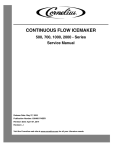
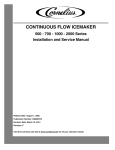
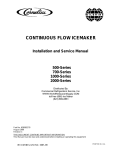
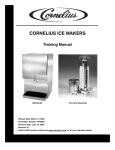
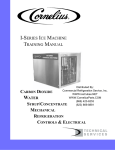
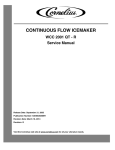
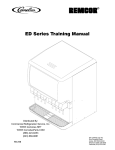
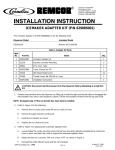
![WCC-700 Service Manual [ 058047 ]](http://vs1.manualzilla.com/store/data/006032662_1-9beff2067bf07b85dc4c0d9ee1d42eb7-150x150.png)

